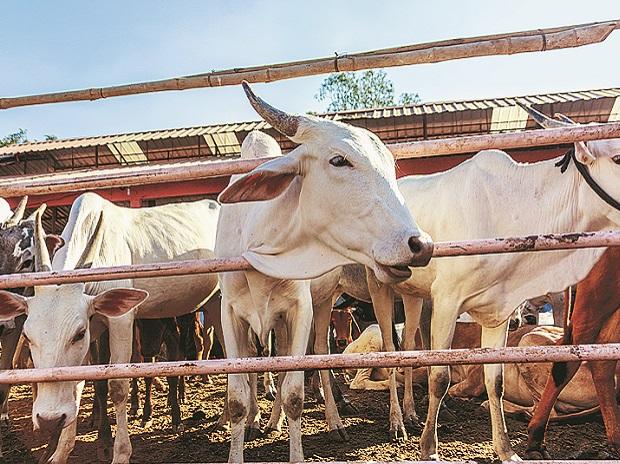Though there has been minimal impact of the lumpy skin disease (LSD) on milk production in the country, states are wary of the viral infection’s long-term effect on cattle fertility.
Some of the worst affected states like Gujarat, Rajasthan, and Madhya Pradesh have so far unofficially pegged the decline in milk production at less than 1 per cent, even as the respective animal husbandry departments continue to collate data. Others like Bihar, which were the worst hit last year, have done better due to growing cattle immunity.
“Currently, milk production has not gone down but has actually improved for the cooperatives. However, there seems to be some impact on private dairies. But what needs to be seen is the long-term impact on the milking cattle since the disease not only affects their fertility but may also impact the new progeny whose productivity might see an impact,” said a senior official at Rajasthan Cooperative Dairy Federation (RCDF).
The dairy federation in Rajasthan has seen a 20 per cent growth in the month of September on a year-on-year (YoY) basis on the back of higher procurement pricing of Rs 850-900 per kilo compared with private dairies. In September 2021, RCDF had procured 2.4-2.5 million litres of milk. The growth in milk procurement this year is despite Rajasthan so far reporting cattle casualties of nearly 50,000 because of LSD.
A viral infection caused by the Capripox virus, closely related to the goat pox virus, LSD causes high fever, superficial lymph nodes, skin ulcers or scars, emaciation, and reduced milk production.
In Gujarat, which is the second worst affected state in terms of casualties at over 5,000, milk production had fallen to about 50,000 litres a day, but has recovered slightly to 100,000 litres a day now. Yet, the state records average daily milk procurement of over 20 million litres, placing the current loss of production at just 0.5 per cent.
Also read: Lumpy skin disease may be controlled in a month, says Sanjeev Balyan
“Milk procurement has been down by almost 100,000 litres daily, up from the previous low of 50,000 litres a day. However, it is not easily possible to point out LSD as the sole reason for decline in milk production. Apart from LSD outbreak in large milk procuring districts such as in North Gujarat, there have also been festivals in these regions where villages suspend milk sale till mid-September,” said R S Sodhi, managing director of Gujarat Cooperative Milk Marketing Federation (GCMMF).
A senior animal husbandry department official in the Madhya Pradesh government, too, confirmed that milk output was down by less than 1 per cent.
“However, data is still being collated on the total number of infected animals. Initial surveys show that the share of milking cattle is relatively low compared to stray cattle affected by LSD. Moreover, the animals already infected over the last one year are expected to develop some natural immunity. Yet, time will tell the kind of impact LSD will have on overall productivity and fertility going forward,” the senior official stated.
Minister of State for Animal Husbandry, Fisheries and Dairying Sanjeev Balyan recently told Business Standard that the impact on the country’s milk production would be minimal.
“The disease is more in cows and we in India have around 100 million breeding cows of which around 1 million have been infected. So, you can understand how much will be the impact on milk production. I don’t think there will be any big impact of LSD on the country’s milk production. It will be less than 1 per cent,” the minister told Business Standard on the sidelines of the World Dairy Summit (WDS) being held in Delhi.
Gujarat government sources said, so far, around 145,000 heads of cattle have been affected, of which roughly 116,000 have been treated. It is, however, in terms of casualties that Gujarat stands next to Rajasthan with over 5,200 heads of cattle succumbing to the disease since the outbreak in April.
Despite the high fatality rate, officials in the Gujarat’s animal husbandry department maintained that it is being brought under control through the inoculation drive.
According to a senior official in the animal husbandry department of Government of Gujarat, the administration has ramped up the vaccination in the last month or so, and that appears to be bringing the situation under control.
“Of more than 26 million cattle in the state, already nearly 6 million have been inoculated with preventive vaccine doses. The vaccination drive has also brought down the number of daily new cases in Gujarat to 1,500-1,800 as against more than 2,000 a while ago,” the senior official stated.
Meanwhile, based on government directives to provide 1 ml dose instead of 3 ml previously, Ahmedabad-based animal vaccine major Hester Biosciences has so far supplied 300,000-400,000 vials. As a result, the company has helped inoculate more than 40 million animals since each vial can vaccinate 100, said founder CEO and Managing Director Rajiv Gandhi, while adding that doses have been supplied to states like Gujarat, Rajasthan, Madhya Pradesh, Punjab, and Maharashtra.





GIPHY App Key not set. Please check settings